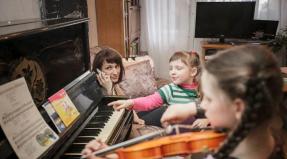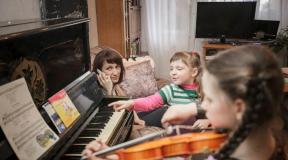Knitted Easter chickens. Description of crochet. Easter chicken Easter chickens and bunnies crochet patterns
Recently, for many holidays, a lot of hand-made, crocheted accessories have appeared: New Year, Birthday, March 8, February 23, Easter. Eggs, hens, chickens, eggs have become traditional. Crocheting an openwork chicken is very interesting. It will create a festive atmosphere and decorate any home interior. Crocheted chicken pattern and description in our article.
How to knit an openwork chicken
In order to knit a tender chicken you will need thin white cotton threads, a little red, a hook of a suitable size (usually 1.00 or 1.25), two small black beads for the eyes.
The following types of loops will be used in crocheting: chain stitches, single and double crochet stitches, as well as connecting stitches.
Start knitting from the head of the chicken.
Crochet 5 chain stitches and connect them into a ring, then make 3 lifting loops. Then knit 9 stitches with one crochet into the hole formed. Move to the next row. Start with 4 chain stitches, and two double crochets in the same stitch. Next, under each next column, knit three stitches with 2 double crochets. There are 30 loops in total. Fasten the thread and cut it.
Make a second circle exactly the same, but do not break the thread. Attach the first finished piece to the resulting circle and sew them with connecting columns in a circle, but not completely, but leaving 8 loops on each side. Do not break the thread, but continue to crochet.
In the first row, crochet one column with two crochets from each loop. Only 16 pieces.
2nd row. Do 3 stitches and one more chain lift. Now, under each stitch, tie a double crochet stitch, alternating a chain stitch between them.
3rd row start with 4 stitches. From the same base loop, knit a column with two double crochets, knit 2 ch. From the lower chain stitches of the previous row, knit two columns with two yarn overs and 2 ch. Do this until the end of the row.
4th r. Knit 4 stitches again. and 2 v.p. Now from the bottom chs of the previous row, make three sts with 2 yarn overs. Crochet in this pattern until the end of the row.
5th r. 4 stitches under, from the same base knit 2 more stitches with two stitches, 2 ch. Next, knit columns from the air stitch of the bottom row. Three double crochets and 2 ch. – repeat this combination three times.
Now knit the base for the future chicken tail. It will be placed on the next eight chain stitches of the previous row. From each, knit like this - * three treble stitches with 2 dc, 2 dc. loops*. Repeat this sequence 8 times. Finish the row like this - two vp, three dc each. Fasten the thread, trim and hide the tip.
Chicken tail knitting pattern
Attach the thread in the place where you started knitting the base for the chicken tail, i.e. into those two air loops located in front of the complex between a pair of three columns. Crochet pattern:
1st row from one loop 3 columns with two chain stitches, 2 chain stitches, complex * 3 sts with 2 chain stitches from one base loop, 2 chain stitches between them, again 3 stitches with 2 chain stitches *. Repeat from * to * – 3 times (complex #1). Then, focusing on the diagram, knit not in air loops, but between complexes. Crochet the module from one loop 2 tbsp. with 2 double crochets, 2 chain stitches, 2 treble crochets. (module #2). Then knit complex #1 twice, module #2 once and complex #1 three times. Finish the row with two stitches and three columns with 2 stitches coming from one loop.
2nd p start with trio st. with 2 nac, make 2 ch. and connect Complex #1 between a pair of v.p. last row. There should be 10 pieces of these complexes in total. Complete the row in the same way as at the beginning of this row. – 2 v.p. and three pieces tbsp. with two nak.
3rd r. Crochet the next two rows only with ordinary columns and chain stitches. Make columns under the arches of the previous row, and between the complexes. There should be a total of 21 of them. Separate them with five chain stitches.
Knit the 4th row similarly to the third. Place the columns under the arches and also separate them with five vp.
5th final row. You need to focus on the diagram. You need to knit a Module of one loop, consisting of eight stitches with 2 stitches. Moreover, connect a pique between a pair of columns. Pique is a connected 5 chain stitches from one base loop. There should be three such piques on each module, and the modules themselves must be crocheted in 9 pieces. It is advisable to constantly look at the presented pattern so as not to get confused in knitting.
The basic crocheting of a delicate openwork chicken is finished. Now you need to take a red thread and make the chicken a comb and beak.
Chicken head design diagram
As you can see from the picture, to make a scallop you need to connect the red thread to the fifth connection. loop on the head of the chicken, tie * 1 sc, then 5 pieces with one crochet *. Repeat from * to * 3 more times and finish with one sc.
The chicken's beak is knitted in simple stbn. Connect the red thread from the opposite side of the head to the third connecting loop and make two connections. loops 4 sc. Unfold the knitting and make 3 sc, turn again - 2 sc, and at the end 1 sc.
All that remains is to sew one black bead onto the head. The beautiful Easter chicken is ready!
Now you need to starch the chicken. Sugar syrup will also work. The product must be kept in the solution and then dried in air at room temperature on a suitable mold.
You can make several of these openwork beauties using crochet. Threads can be combined as desired.

Easter chickens: video master class
Chicken for Easter: MK video
Are you ready crochet Easter chicken?
After all, the most family-friendly and brightest spring holiday is, of course, Easter. Both children and adults adore Easter cakes, painted eggs, wicker baskets and clean white Easter towels with candles. And, of course, Easter is unthinkable without chickens!
That is why we suggest taking up Easter knitting.
Their peculiarity is that they are not always filled with padding polyester or other filler. A real or decorative egg is placed in them. So these hens and cockerels are the real keepers of Easter eggs. Presenting such a surprise to mom, grandparents or children for Easter is the best solution to the annual gift problem. Inexpensive, healthy and tasteful!
How to crochet a chicken, see the links below:

Crocheted Easter chickens. Schemes and master classes
4. Knitting Easter chickens from the website "Master Classes".
5. Easter chicken, diagram from the site "School of a Young Mother".
6. Crochet Easter chicken, diagram and master class from Natalia Grukhina.
How to crochet an Easter chicken. Video master classes
Easter chicken amigurumi:
How to crochet a chicken on an egg:
DIY crochet Easter chicken:
We have already presented before. For those who for some reason are uncomfortable knitting from a video, we offer a step-by-step description of knitting Easter hens.
Provided by Bukavin N.S.
You will need: 50 g of white yarn, 20 g of pink, green and blue yarn each (100% cotton, 210 m/50 g), hook No. 1.5, pins or marker.
Execution. Start knitting with an “amigurumi ring”. Wrap the working thread around your finger twice and tie 16 tbsp into the resulting ring. b/n. After this, gently pull the thread, tightening the ring. Then knit in a spiral (without lifting loops to a new row) as follows:
From the 1st to the 7th row - 16 tbsp. non-cash, work done with white yarn;
8th row - add loops, knit 2 tbsp from each loop. b/n., at the end of the row there should be 32 stitches, work done with white yarn;
9th row - use a pin or marker to highlight the middle of the ponytail (make a mark between the loops). Next, add as follows: from two loops to the mark, knit 2 tbsp. b/n., then from two loops after the mark, knit 2 tbsp. b/n. (added 4 points). At the end of the row there are 36 loops, work with white yarn;
10th row - similarly as in the 9th row, make additions (add 4 stitches), at the end of the row there are 40 stitches, work with white yarn;
11th row - knit without adding st. non-cash, work done with pink, green or blue yarn;
12th row - make additions in the ponytail on both sides. At eight st. b/n. knit 2 tbsp to the mark. s/n. (8 p. added), and at eight st. 6/n. after the mark, knit 2 tbsp. s/n. (8 sts have been added), at the end of the row there should be 56 sts, work done with white yarn;
13th row - knit without increments. At the station b/n. knit st. b/n., at st. s/n. knit in s/n stitches, work with pink, green or blue yarn;
14th row - knit without adding st. b/n.;
15th row - make additions in the ponytail on both sides. On sixteen loops up to the mark, knit 2 tbsp. s/n. (16 stitches have been added) and on 16 loops after the mark, knit 2 tbsp. s/n., at the end of the row there are 88 sts, work with pink, green or blue yarn;
16th row - on uncapped columns. knit in b/n columns. At the station s/n. knit *2 tbsp. b/n., 1st century. p.*, work with white yarn;
17th row - on uncapped columns. knit 2 sts together. b/n. In the ponytail on air loops, knit st. b/n., alternating them with arches from 3 c. etc., do the work with pink, green or blue yarn.
Scallop. Knit 3 arches from 5th century. p.
Beak. Three in. p.
Eyes. For the eyes, use beads, sequins, small stones - they can be sewn or glued, and with a needle and thread you can embroider the eyes.
Easter greetings are always memorable with gifts. An Easter bunny with pockets for eggs, a master class for which I decided to provide you with, will be a wonderful gift and a great toy. By the way, you can put not only colored eggs in the pockets, but also sweets and all sorts of other goodies.
By the way, pay attention to the knitted ones in the background. If you follow the links, you will be taken to a detailed master class on knitting them.
What you need for the Easter Bunny:
- acrylic yarn Pekhorka Handmade, 50 grams in a skein, 175 meters.
- hook 1.7.

And also for small details and, if you knit yourself, eggs, all sorts of colorful leftovers.

Crochet Easter Bunny with pockets for eggs – start crocheting the figure from the head
The beginning will be a ring made of thread, 6 single crochets are typed into it (sc)
1 row. 6 sc.

Now, we will tighten the remaining end of the thread and continue to knit it in a spiral, without making a lifting loop.
2nd row. 6 + 6 = 12 sc. Let's make two in each column.

3rd row. 12 + 6 = 18 sc. We knit two in every second column. 
4 row. 18 + 6 = 24 sc. We will knit two stitches in every second stitch. 
5 row. 24 + 6 = 30 sc. In every third we will make two columns. 

7 - 9 rows. 36 sc.
10 row. 36 - 6= 30 sc. You must skip, without knitting, every fifth stitch.

11 row. 30 - 6 = 24 sc. We don’t knit every fourth one.
12 row. 24 - 6 = 18 sc. We skip every third one.
13 row. 18 - 6 = 12 sc. We knit it through a post, then fill it with padding polyester; it is better to put the filler in small lumps so that there are no holes or bumps on the surface of the head. 
14 - 16 rows. 12 sc. This will be the neck. 
17th row. 12 + 6 = 18 sc. We make 3 air loops for lifting (vpp) (3 air loops replace 1 dc), 2 double crochets (dc) in one loop, then we knit 1 dc, 2 dc in 1 loop, etc. We connect the beginning to the end using a connecting loop.

18th row. 3 run, 1 fluffy column (ps), 2 dc, 1 ps, 2 dc, 1 ps. A lush column is knitted like this: we knit 3 loops and 3 yarn overs into one loop of the bottom row.

19 - 28 rows. We knit in the same way, only we add one double crochet between the lush columns.
In the last 28 row there should be: 3 VP, 1 ps, 11 dc, 1 ps, 11 dc, 1 ps, 11 dc, 1 ps, 11 dc, 1 ps, 11 dc, 1 ps, 10 dc, 1 sp
(connecting loop).

29 row. 84 sc. 12 sc between ps and in each ps we make 2 sc.
Row 30 84 + 6 = 90 sc. We make two dc every fourteenth.
31 row. 90 + 6 = 96 sc. We do 2 dc every fifteenth. These three rows will be the bottom for the pockets.

32 row. 3 runways and turn the knitting over, we will knit on the wrong side like the front side. We knit again with double crochets and puffy stitches. 1 ps, 15 dc, 1 ps, 15 dc, 1 ps, 15 dc, 1 ps, 15 dc, 1 ps, 15 dc, 1 ps, 14 dc, 1 sp. 
33 row. 3 run, 1 ps, 16 dc...1 ps, 15 dc, 1 sp.
34 row. 3 run, 1 ps, 17 dc...1 ps, 16 dc, 1 sp.
Row 35 3 run, 1 ps, 18 dc...1 ps, 17 dc, 1 sp.
36 row. 3 run, 1 ps, 19 dc...1 ps, 18 dc, 1 sp.
37 row. 3 run, 1 ps, 20 dc...1 ps, 19 dc, 1 sp.
38 row. 3 run, 1 ps, 21 dc...1 ps, 20 dc, 1 sp.

Here you can cut off the blue thread and take any other thread to finish the edges of the pockets. We will have white.
39 row. 22 sc in white we tie the edge, having reached the ps, we raise a chain of 3 ch (chain loops)


We will knit a loop and follow the ch chain back to the edge, knitting 3 sc. We continue to tie the edge of the sc, repeating the operation with air loops on each lush column 

Easter bunny ears with pockets
1 row. 5 sc in the ring.
2nd row. 5 + 5 = 10 sc.
3 - 4 rows. 10 sc.
5 row. 10 + 2 = 12 sc.
Row 6. 12 sc.
7th row. 12 + 3 = 15 sc.
8 - 12 rows. 15 sc.

Let's cut the thread so that it's enough to sew to the head. Let's make a second ear, in
Fold the base in half, grab the edges and sew.

For the muzzle, take a white thread and start with a ring into which we collect 6 sc.
1 row. 6 sc.
3rd row. 12 + 3 = 15 sc. Cut the thread and sew it on. 
All that remains is to make our bunny's eyes and nose. For the nose, we will use a pink thread and simply embroider the nose on the muzzle, and we took ready-made plastic eyes, the kind they sell in craft stores.
But if for some reason you do not have the opportunity to buy ready-made eyes, then you can also embroider them with thread.
Read also...
- Identification of the level of formation of aesthetic education The principle of creative amateur performances of schoolchildren
- Why a newborn baby constantly cries: reasons and proven ways to quickly calm an infant
- Wear hats correctly - beanies, sock and other new words in the encyclopedia of headwear Ideas for hairstyles for hair of different lengths
- The best thermal protection for hair: which one to choose and how to make the right choice Thermal protective sprays for hair rating



















